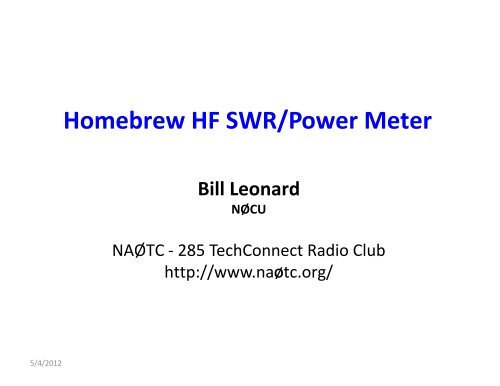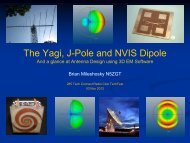Homebrew HF SWR/Power Meter - 285 TechConnect Radio Club
Homebrew HF SWR/Power Meter - 285 TechConnect Radio Club
Homebrew HF SWR/Power Meter - 285 TechConnect Radio Club
You also want an ePaper? Increase the reach of your titles
YUMPU automatically turns print PDFs into web optimized ePapers that Google loves.
5/4/2012<br />
<strong>Homebrew</strong> <strong>HF</strong> <strong>SWR</strong>/<strong>Power</strong> <strong>Meter</strong><br />
Bill Leonard<br />
NØCU<br />
NAØTC - <strong>285</strong> <strong>TechConnect</strong> <strong>Radio</strong> <strong>Club</strong><br />
http://www.naØtc.org/
•Standing Waves<br />
Theory<br />
<strong>SWR</strong> = 3:1<br />
Dynamic Demo: http://www.walter-fendt.de/ph14e/stwaverefl.htm<br />
5/4/2012
•<strong>SWR</strong> Calculation<br />
•Not a direct measurement<br />
5/4/2012<br />
<strong>SWR</strong> =<br />
1+<br />
1-<br />
P R<br />
P F<br />
P R<br />
P F<br />
Theory<br />
=<br />
E F<br />
+<br />
E F -<br />
E F = Forward Voltage<br />
E R = Reverse Voltage<br />
P F = Forward <strong>Power</strong><br />
P R = Reverse Voltage<br />
<strong>SWR</strong> accuracy is only as good as the power measurement<br />
accuracy (both Forward & Reflected)<br />
E R<br />
E R
Theory<br />
•How should RF <strong>Power</strong> be measured?<br />
1. RF voltmeter connected at the output of the transmitter<br />
5/4/2012
Theory<br />
•How should RF <strong>Power</strong> be measured?<br />
1. RF voltmeter connected at the output of the transmitter<br />
No!<br />
5/4/2012<br />
1. Voltage reading is dependent upon load impedance at the point<br />
of measurement<br />
• <strong>Power</strong> meters on Ameritron <strong>Power</strong> Amplifiers<br />
2. To determine power, we need independent measurements of<br />
voltage and current
Theory<br />
•How should RF <strong>Power</strong> be measured?<br />
1. RF voltmeter connected at the output of the transmitter<br />
2. Use a TRUE POWER meter that can measure both current<br />
and voltage of both the forward and reflected waves<br />
5/4/2012
5/4/2012<br />
RF<br />
IN<br />
Sensor<br />
Directional<br />
Coupler<br />
X X<br />
Envelope<br />
Detectors<br />
RF <strong>Power</strong> <strong>Meter</strong> Components<br />
Forward<br />
Reflected<br />
RF <strong>Power</strong> <strong>Meter</strong><br />
*<strong>Meter</strong> can be:<br />
• Analog or digital<br />
• Current or voltage<br />
•0-100 uA typical (non-powered)<br />
Switch<br />
<strong>Meter</strong>*<br />
RF<br />
OUT
5/4/2012<br />
RF<br />
IN<br />
Sensor<br />
Directional<br />
Coupler<br />
X X<br />
Envelope<br />
Detectors<br />
<strong>SWR</strong>/<strong>Power</strong> <strong>Meter</strong> - Digital<br />
Forward<br />
Reflected<br />
Digital<br />
Processor<br />
Digital<br />
Display<br />
RF<br />
OUT
5/4/2012<br />
Alpha 4520 Digital <strong>Power</strong>/<strong>SWR</strong> <strong>Meter</strong>
5/4/2012<br />
RF<br />
IN<br />
Sensor<br />
Directional<br />
Coupler<br />
X X<br />
Envelope<br />
Detectors<br />
<strong>SWR</strong>/<strong>Power</strong> <strong>Meter</strong> - Digital<br />
RF<br />
OUT<br />
Forward<br />
Reflected<br />
Processor<br />
Digital<br />
Display
5/4/2012<br />
RF<br />
IN<br />
Sensor<br />
Directional<br />
Coupler<br />
X X<br />
Envelope<br />
Detectors<br />
<strong>SWR</strong>/<strong>Power</strong> <strong>Meter</strong> - Digital<br />
RF<br />
OUT<br />
Forward<br />
Reflected
5/4/2012<br />
My Digital <strong>Power</strong> <strong>Meter</strong><br />
uV<br />
Resolution:<br />
100W/40000 uV = 0.025 W/uV
Sensor<br />
Forward<br />
Reflected<br />
5/4/2012<br />
Digital <strong>Power</strong>/<strong>SWR</strong> <strong>Meter</strong>s<br />
What is the main difference?<br />
Alpha 4520
Sensor<br />
Forward<br />
Reflected<br />
~$0-50<br />
5/4/2012<br />
Digital <strong>Power</strong>/<strong>SWR</strong> <strong>Meter</strong>s<br />
$30 up<br />
Cost!<br />
Alpha 4520<br />
$800
Sensor<br />
Forward<br />
Reflected<br />
Digital <strong>Power</strong>/<strong>SWR</strong> <strong>Meter</strong>s<br />
Accuracy varies from ~5% to ?<br />
•<strong>Power</strong> reading accuracy is very dependent on Sensor<br />
calibration accuracy (both Forward & Reflected)<br />
Accuracy: 5-10% achievable<br />
5/4/2012<br />
Alpha 4520<br />
Accuracy Spec =
Ultimate Limit on Accuracy?<br />
•Sensor Calibration!<br />
•Initial CAL accuracy<br />
•Volts out vs <strong>Power</strong> In<br />
•<strong>SWR</strong> is a calculation, not a measurement<br />
•Volts out vs Frequency<br />
•Traceable to NIST?<br />
•Drift with time<br />
•Load impedance drift with heating (1-3 KW???)<br />
•Having a digital readout:<br />
•Doesn’t improve accuracy<br />
•Improves resolution<br />
•May improve repeatability<br />
•Having a digital processor does allow for better<br />
calibration of sensor characteristics<br />
5/4/2012
Telepost LP-100A Digital Vector Wattmeter<br />
•Accuracy:<br />
•Same specs as Alpha 4520<br />
•5% maximum<br />
•3% (typical)<br />
•NIST traceable factory calibration<br />
•What does this mean?<br />
•eHam rating: 5.0/5 (121 reviews)<br />
•$435<br />
5/4/2012
5/4/2012<br />
RF<br />
IN<br />
Sensor<br />
Directional<br />
Coupler<br />
X X<br />
Directional Coupler<br />
RF <strong>Power</strong> <strong>Meter</strong><br />
RF<br />
OUT
Directional Coupler<br />
•Only couples power flowing in one direction<br />
•Only couples a small sample of the power flowing in the desired direction<br />
RF<br />
IN<br />
Green = desired coupling<br />
Red = undesired coupling<br />
X<br />
Forward<br />
Coupler<br />
X<br />
•Coupling factor represents the primary property of a directional coupler<br />
•To reduce 100 w to 100 mw => Coupling factor = -30 dB<br />
•Directivity is the measure of how well a coupler isolates two oppositetravelling<br />
(forward and reverse) signals<br />
•Creates region of uncertainty around all measurements<br />
•Bird 43: Directivity >30 dB<br />
5/4/2012<br />
Forward<br />
RF<br />
OUT
RF<br />
IN<br />
Green = desired coupling<br />
Red = undesired coupling<br />
5/4/2012<br />
Dual Directional Coupler<br />
X<br />
Forward<br />
Coupler<br />
X X X<br />
Reverse<br />
Coupler<br />
Forward Reflected<br />
RF<br />
OUT
Coupled Transmission Line Coupler<br />
5/4/2012<br />
Common Directional Couplers<br />
Bird 43
Tandem Match Coupler<br />
Bruene Bridge*<br />
5/4/2012<br />
Common Directional Couplers<br />
*Most common type<br />
found in commercial<br />
amateur transmitters
Tandem Match Coupler<br />
Bruene Bridge*<br />
5/4/2012<br />
Common Directional Couplers<br />
How do we get Voltage & Current?<br />
*Most common type<br />
found in commercial<br />
amateur transmitters
Tandem Match Coupler<br />
Bruene Bridge*<br />
5/4/2012<br />
Common Directional Couplers
Tandem Match Coupler<br />
Bruene Bridge*<br />
5/4/2012<br />
Common Directional Couplers<br />
Null adjustment
Common Sensors<br />
•Tandem Match Coupler<br />
•This coupler has some nice features:<br />
•Simplicity, excellent directivity<br />
•Scalable to other power levels, and<br />
•50-Ω load impedances on all ports<br />
•Covering 1.8-30 MHz requires careful transformer design<br />
•Input V<strong>SWR</strong> can degrade rapidly as frequency drops below 7 MHz<br />
•Bruene Bridge<br />
•Requires comparatively little space<br />
•Most commonly used design by Ham equipment manufacturers<br />
•Primary challenges with this design:<br />
1. Parasitic lead inductance associated with C2<br />
2. High values for C2<br />
3. Excessive secondary wire length on T1, and<br />
4. Impedance control in the bifilar secondary winding<br />
•The lead inductance and C2 result in a series resonance that<br />
progressively deteriorates bridge balance as the frequency is raised<br />
5/4/2012
5/4/2012<br />
Tandem Match Coupler<br />
<strong>SWR</strong> Sensor (from 2010 ARRL Antenna Handbook)
5/4/2012<br />
Tandem Match Coupler<br />
Shield on coax used as a Faraday shield (grounded on one end only)<br />
<strong>SWR</strong> Sensor (from 2010 ARRL Antenna Handbook)<br />
Any small signal diode will work<br />
(Germaniums are best for QRP)<br />
At 100 watts, I FWDOUT (into a short) > 6 mA<br />
At 100 watts, V FWDOUT (into an open) > 2.0 vdc
Caution: Germanium diodes don’t like heat<br />
5/4/2012<br />
Tandem Match Coupler
5/4/2012<br />
Tandem Match Coupler Using Balun Core<br />
DX Zone.com ”Digital QRP <strong>SWR</strong>/ <strong>Power</strong> <strong>Meter</strong>” by KD1JV<br />
Compensation Diodes<br />
(I don’t recommend)
Processor/Display<br />
DX Zone.com ”Digital QRP <strong>SWR</strong>/ <strong>Power</strong> <strong>Meter</strong>” by KD1JV<br />
“Whitman’s Sampler” tin<br />
•http://kd1jv.qrpradio.com/<br />
•http://www.dxzone.com/cgi-bin/dir/jump2.cgi?ID=18048<br />
5/4/2012
5/4/2012<br />
RF<br />
IN<br />
Sensor<br />
X X<br />
Envelope<br />
Detectors<br />
Envelope Detector<br />
RF <strong>Power</strong> <strong>Meter</strong><br />
RF<br />
OUT
Forward<br />
Reflected<br />
5/4/2012<br />
51<br />
51<br />
Diode<br />
0.01 uF<br />
Diode<br />
0.01 uF<br />
Common Envelope Detector<br />
100K<br />
100K<br />
Diodes:<br />
•Type not critical<br />
•Germanium best for QRP<br />
•Matched is desirable, but not required
Diode Options<br />
Silicon:<br />
•1N3600 => V D ~0.7 volt<br />
Germanium:<br />
•1N34, 1N60, 1N270 => V D ~ 0.3 volt<br />
5/4/2012
VDC<br />
5/4/2012<br />
2.5<br />
2<br />
1.5<br />
1<br />
0.5<br />
0<br />
Diode Matching -Tandem Match Coupler<br />
Diode type dependent<br />
?<br />
No matching attempted<br />
0 10 20 30 40 50 60 70 80 90 100<br />
Watts<br />
1N34A-1<br />
1N34A-2
Forward<br />
Reflected<br />
2 vdc<br />
5/4/2012<br />
Source<br />
51<br />
51<br />
Diode<br />
0.01 uF<br />
Diode<br />
~ 300 ohm<br />
0.01 uF<br />
Isolated <strong>Meter</strong> Circuit<br />
1 uF<br />
100K<br />
100K<br />
3<br />
2<br />
5<br />
6<br />
+<br />
- 1 4<br />
1<br />
Forward OUT<br />
11<br />
1<br />
+<br />
- 2 Reflected OUT<br />
+X VDC<br />
7<br />
780X<br />
1 uF<br />
+V IN<br />
LM324 or equivalent<br />
3<br />
4
Forward<br />
Reflected<br />
5/4/2012<br />
51<br />
51<br />
Diode<br />
0.01 uF<br />
Diode<br />
0.01 uF<br />
1 uF<br />
100K<br />
100K<br />
<strong>Meter</strong> Adjustment<br />
3<br />
2<br />
5<br />
6<br />
+<br />
- 1 4<br />
1<br />
Level<br />
Forward OUT<br />
11<br />
+<br />
+X VDC<br />
FWD<br />
Adjust<br />
REF<br />
780X<br />
1 uF<br />
- 2 7<br />
Level<br />
Reflected OUT<br />
Adjust<br />
+V IN
5/4/2012<br />
A SIMPLE <strong>SWR</strong> METER FOR QRP (1 WATT) LEVELS<br />
Not required<br />
X<br />
X<br />
X
<strong>Homebrew</strong><br />
(Tandem Match)<br />
Bird<br />
(Coupled Line/Digital)<br />
5/4/2012<br />
Pride<br />
(Breune)<br />
Performance – <strong>Power</strong> Measurement<br />
VDC<br />
mVDC<br />
Watts<br />
2.50<br />
2.00<br />
1.50<br />
1.00<br />
0.50<br />
0.00<br />
50<br />
40<br />
30<br />
20<br />
10<br />
0<br />
100<br />
80<br />
60<br />
40<br />
20<br />
0<br />
0 2 5 10 20 30 40 50 60 70 80 90 95 100<br />
2 5 10 20 30 40 50 60 70 80 90 95<br />
0 10 20 30 40 50 60 70 80 90 100<br />
Watts<br />
Diode type dependent
5/4/2012<br />
3.0<br />
2.5<br />
2.0<br />
1.5<br />
1.0<br />
Performance – <strong>SWR</strong> Measurement<br />
25 ohm Load @ P F = 60 watts<br />
1.8 MHz<br />
14 MHz<br />
28 MHz<br />
Tandem<br />
Bird<br />
Breune
Reflected<br />
Forward<br />
5/4/2012<br />
100K<br />
100K<br />
5<br />
6<br />
3<br />
1 uF<br />
2<br />
200K<br />
Latch<br />
Treshold<br />
+<br />
- 2<br />
FWD<br />
+<br />
- 1<br />
4<br />
11<br />
7<br />
LM324<br />
1<br />
<strong>SWR</strong> Protection Circuit<br />
150K<br />
+8 VDC<br />
REF<br />
Reflected<br />
<strong>Power</strong><br />
0.1 uF<br />
15K<br />
15K<br />
1.21M<br />
Foldback<br />
Treshold<br />
1.0 uF<br />
1K<br />
10K<br />
12<br />
13<br />
+<br />
- 4<br />
To<br />
+4 VDC<br />
7808<br />
0.1 uF<br />
~1 sec Delay<br />
to Latch<br />
1.0 uF<br />
15K<br />
+1.6 VDC<br />
14<br />
+4 VDC<br />
1N3600<br />
1 uF<br />
10<br />
9<br />
5.1K<br />
+<br />
- 3<br />
Reset<br />
0.1 uF<br />
5.1K<br />
1.1K<br />
8<br />
2N3501<br />
+12 VDC<br />
To<br />
+8 VDC<br />
17 mA<br />
10K<br />
1N3600<br />
100<br />
1N3600<br />
2N3501<br />
13<br />
1<br />
16<br />
2N3501<br />
390<br />
½ W<br />
Latch<br />
Relay1<br />
11<br />
9<br />
+<br />
-<br />
2N3501<br />
Latch Relay1<br />
6<br />
8<br />
+<br />
-<br />
4<br />
<strong>SWR</strong> LED<br />
<strong>Radio</strong> Shack<br />
276-0017<br />
+13.5<br />
VDC<br />
To <strong>SWR</strong><br />
Shutdown<br />
To<br />
+13.5 VDC



